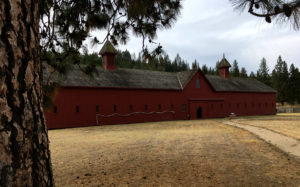To walk the grounds of Fort Spokane is to walk in the footsteps of change. Fort Spokane has a changing story, from serving as a frontier military post, to an Indian boarding school, a tuberculosis hospital and sanitarium, and now as a National Park. Fort Spokane is part of the Lake Roosevelt National Recreation Area and located above the confluence of the Spokane and Columbia Rivers in eastern Washington.
Built in1880, Fort Spokane first served as a frontier military post. Many soldiers joined the Army hoping to see fighting on the frontier, but the fight against boredom was the only battle the soldiers at Fort Spokane waged. Their monotonous life consisted of waking to the bugle call, eating breakfast, marching the Parade Ground, working in the bakery or standing guard at the Guardhouse, march and drill the manual of arms in the afternoon, play baseball in the evening if weather permitted, eat dinner and go to bed. The tedious days became more than many soldiers could bear. Some turned to drink; some ran away. The guardhouse, originally built to house prisoners of war, ironically housed errant soldiers. The fort closed in 1898 when the soldiers were transferred to Cuba to fight in the Spanish-American War.
Fort Spokane was decommissioned and transferred to the Bureau of Indian Affairs. The fort opened as an Indian boarding school in 1900. Children ages five to sixteen from the Spokane and Colville tribes were removed from their families and sent miles away to the Indian Boarding School at Fort Spokane. At first they did not understand the language of the teachers and staff, yet were not allowed to speak their own language–not even to each other. They were not allowed to wear their native clothing or practice their spiritual traditions. Strict discipline and harsh punishments were the norm. The boys were trained to learn a trade such as gardening and tending chickens and cows. The girls were taught how to keep house and other domestic chores. It was a time of suffering both for the children and for their parents. The school operated from 1900 to 1907.
The last people to occupy the fort were the doctors, nurses and patients of the tuberculosis sanitarium and Indian hospital until Fort Spokane’s final closure in 1929.
Fort Spokane became a part of the National Park Service in 1960. Major restoration involved four of the remaining buildings: the Quartermaster Stable built in 1884, the Powder Magazine built in 1888, the Reservoir built in 1889, and the Guardhouse built in 1892. These structures can be seen today and visitors are encouraged to tour the grounds and buildings. The National Park Service maintains the grounds at Fort Spokane to preserve these stories for future generations.



We have some regrettable things in our past and this reader hopes we can begin to learn from our mistakes. What are the chances?
In many respects we don’t have a great history, do we? However, I think we’ve made progress. Lots of room for improvement though….
Mary, I have enjoyed your interesting journeys. Now that we live in Pullman, Spokane is less than two hours away. Fort Spokane’s history as a military post, school for Native American children and a sanatorium is interesting. Hopefully we will be able to visit it some time. Thank you for writing about it.
I’ve lived in this State for years, Hema, and had never been there until this past summer. We went “before hours” and were still able to see a lot, but the main administration building was closed. I’d like to go back to see that.
You take us on so many journeys, Mary, that I’m having a difficult time choosing which would be my favorite place to travel to. And thank you for sharing this tidbit about Fort Spokane, it’s soldiers, Indian children and doctors and nurses who occupied the fort through the latter part of the 1800s into 1900.
There are so many interesting places to visit in Washington. I can’t wait to hear all about your travels in our State.
Very interesting, Mary. Sadly, that history of taking children from families to “civilize” them was common then and I’m sure it was a big factor in the breakdown of Native culture.
That was certainly a poor decision, though in those days I suppose they thought it was for the best. I can’t imagine how awful it was for those children and their families.